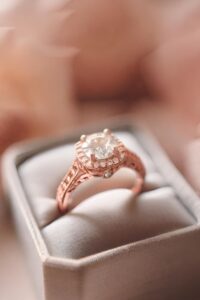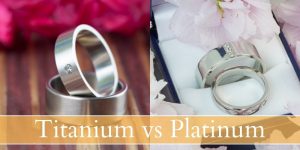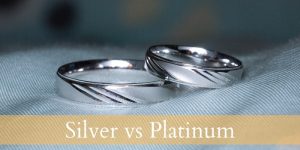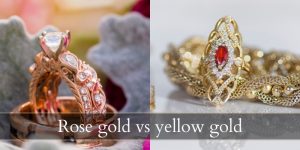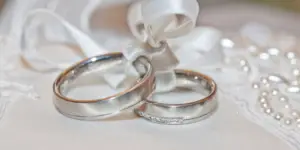Gold is the precious metal of choice for jewelry, especially wedding and engagement rings. If you’re looking for the best gold for your situation, you’re likely looking at 14k vs 18k gold. You’ve probably noticed the differences in price and might be wondering exactly what is the big difference between the two ?
Which one wears better, and why is one cheaper than the other ? Is one plated and the other not ? Is one of them fake ?
We’re enthusiastic about all things jewelry related, and we’ve had this exact discussion when we chose our wedding rings too. Here’s what we found out.
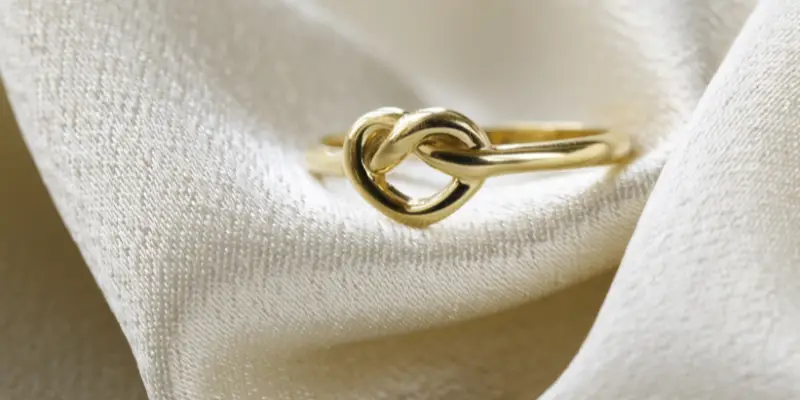
18k gold vs 14k gold
The main difference between 14k and 18k gold is the amount of non-gold metal alloys present in the jewelry. 18k gold is made up of 18 parts pure gold, and 6 parts non-gold metal alloy, while 14k gold is made up of 14 parts pure gold and 10 parts non-gold metal alloys.
In short, 18k gold has the higher percentage of pure gold, compared to 14k. This makes it more expensive, and also less durable because gold is a very soft metal and will wear down. A 14k gold ring will wear better than an 18k gold ring, because it’s blended with sturdier material.
Please keep in mind that 14k and 18k gold is simply the gold purity, and you can find white, yellow, and rose gold in both purities.
14k gold is more affordable than 18k
14k gold has a lower amount of gold in it (58.3%), it simply costs less. The only expensive part in it is the gold, which is a little over half the total weight. Meanwhile, 18k gold has 75% of its weight as gold, meaning the same ring will end up more expensive.
If you’re keeping an eye on your budget, then 14k is definitely the more affordable gold to go with.
18k gold wears down faster than 14k
Because 18k gold has so much more soft gold in it, it’s going to scratch and wear down much faster than a 14k piece of jewelry. This is especially important if you’re picking out rings you’re going to wear every day, and also do a lot of work with your hands.
If you’re reading this to pick the metal for your wedding rings, remember that your engagement ring is going to rub against the wedding band if you wear them together. Take the karat of the engagement ring into account here, because it may wear down your wedding band or vice-versa.
Read also: White Gold VS Silver – Which Is Right for You?
The more the ring touches other materials, the more scratches it will accumulate. Make no mistake, both 14k and 18k scratch and wear down eventually. But 18k does this much faster and you will find yourself taking it to be polished much more frequently.
Because of this, we recommend buying 18k gold for pieces that are not heavily worn, like earrings or tiaras. A bracelet or ring will wear down faster, and you may want 14k gold on that.
14k gold has that classic gold color
An important issue few people realize is that the amount of gold in a piece of jewelry determines its final color. Most of us have grown up with that standard warm, yellow color and we all associate it with gold. In truth, pure gold is nearly orange, a very warm color.
14k gold is mixed with different metal alloys (like silver, copper, platinum, zinc, nickel, or palladium) and thus that beautiful golden color is achieved. 18k gold is a warmer, deeper gold color that may look a bit strange to some.
A bonus point for 14k: since it allows so much non-gold metal, this makes it easier to achieve a truly pink rose gold color. So if you’re looking for rose gold with that nice pink tint, 14k achieves that look much better. 18k rose gold has a much vaguer pink tint. And if we’re discussing white gold the 24k version will look whiter than the 18k one. Both are usually coated in rhodium and the final result is the same, but you can ask your goldsmith to skip that step.
Read also: Yellow Gold VS White Gold
Why is gold blended with other metals ?
Gold is a very soft metal, meaning it will break and scratch and wear down very easily. Blending the gold with a stronger non-gold metal allows the final jewelry piece to be more durable. The more non-gold metal alloy added, the more durable the jewelry. For high-wear pieces like rings and bracelets, this is crucial.
This also means you lose more and more of that beautiful deep gold color, though you can mitigate this by using warmer colors in the alloys.
For example pure gold mixed with silver and palladium bring you a very light yellow (white gold), a colder hue compared to pure yellow. But you can swap the palladium for copper, and still keep the silver, and end up with a warm gold color. Remove some of the gold and add more copper, and you’ve got rose gold !
Really, the color of the gold pieces you see in jewelry stores is a mixture of different alloys and pure gold. Much like mixing paint, the final color depends on what pigments (in this case metals) you’ve used.
What does k stand for ?
The k after 14 or 18 stands for karats, which is the standard measure of fineness and purity in gold. There is no 100% pure gold, but 99.95% pure gold is 24 karat gold.
The karats are used in a 24 parts system, and each karat labeled refers to the gold part. Meaning an 18k gold piece has 18 parts pure gold and 6 parts non-gold.
The highest karat is 24, and this is the softest, purest gold. The lowest karat is 8, with only 8 parts of the jewelry being pure gold.
Does 18k gold tarnish ?
Yes, 18k gold can tarnish but takes a very long time for it to happen. The pure gold in the alloy does not tarnish, as pure gold is non-reactive. But the other metals may react to your skin, sweat, or something else you touch.
The higher the karat, the slower the tarnish. For example 14k gold will tarnish faster than 18k, and 19k will tarnish faster than 14k. All of them do this very, very slowly though, much slower than silver. To completely avoid tarnishing, you want 24k gold. But that is too soft to be used in jewelry or even coins.
This does not mean that 18k gold is fake or un anyway sub-par. It simply means it’s more durable and practical than pure 24k gold. You can easily remove the tarnish by washing the gold piece in mild soap and hot water, and gently rubbing at it with a soft-bristle brush or a soft cloth.
Do this ever year and your gold piece should stay bright and shiny for decades. Gold, no matter the karat, still need to be maintained.
Will 18k gold turn skin green ?
If your 18k gold piece has copper and/or nickel in it, it may turn your skin green, yes. Those two metals are the ones usually responsible for that green color when they oxidate.
It could be sweat, heat, or simply your skin being in contact with the ring. Pure gold does not turn the skin green, since this is a non-reactive metal and hypoallergenic.
Please note that while this is all possible, it’s very unlikely since the amount of gold in 18k is still pretty high. You have a higher chance of green skin if getting 14, 10, or 8 karat gold.
The only way to know if the gold was mixed with copper and nickel is to ask the jeweler, just to be safe. High amounts of copper may show as a pink tint.

I’m the main author for jewelrymaterialguide.com. I started this site after we did tons of research before our wedding and noticed that there is information about rings, jewelry, and so on that is really hard to find on the internet.

